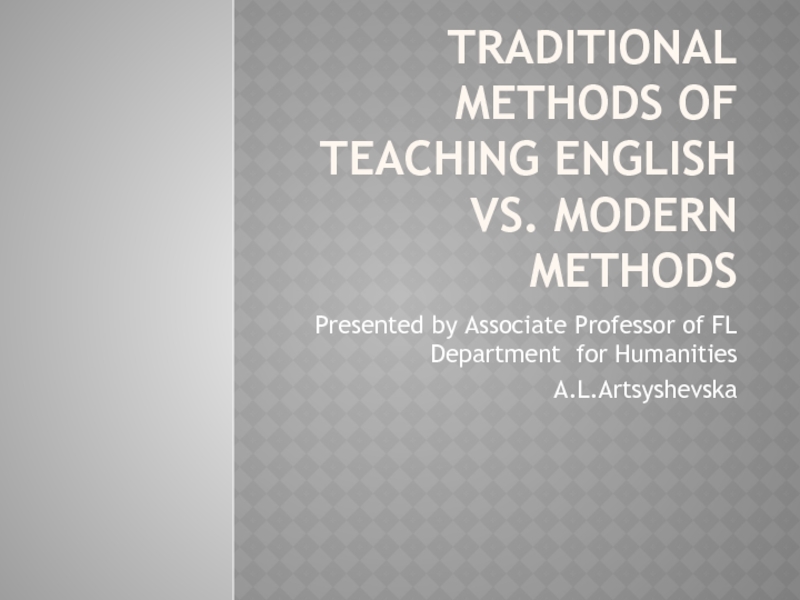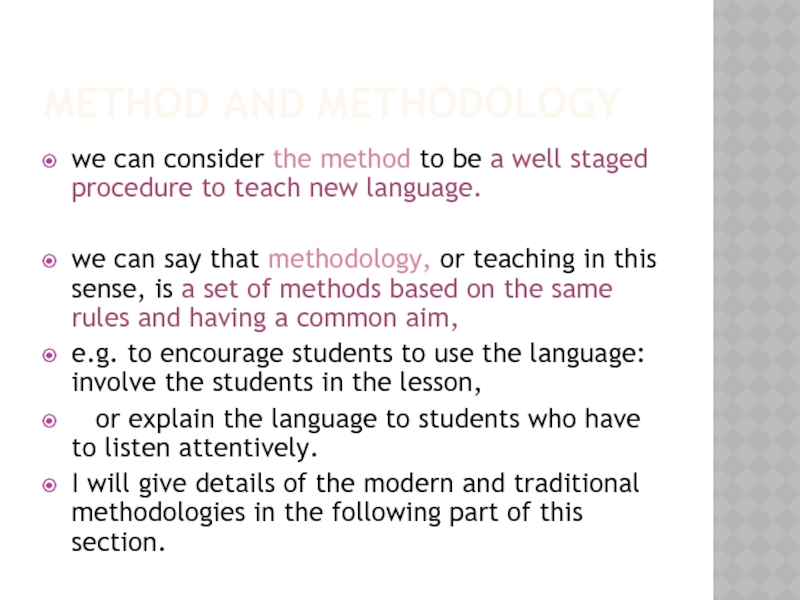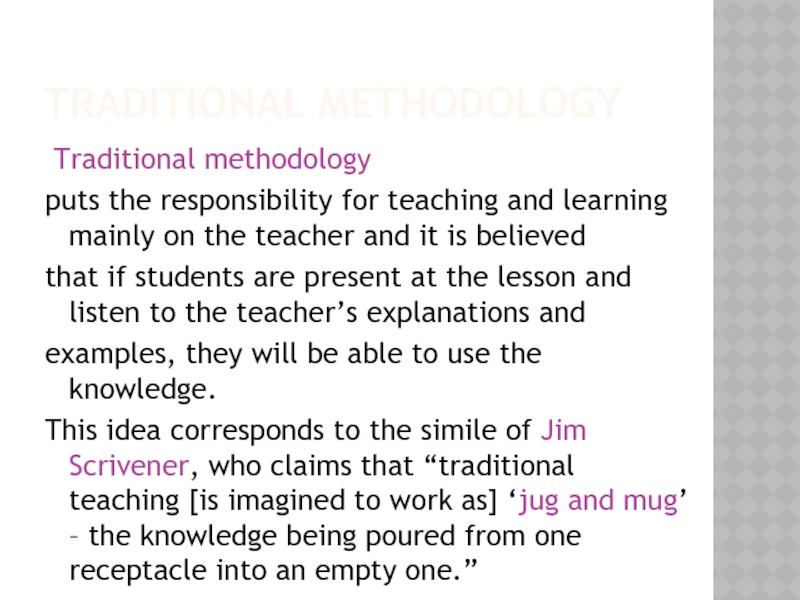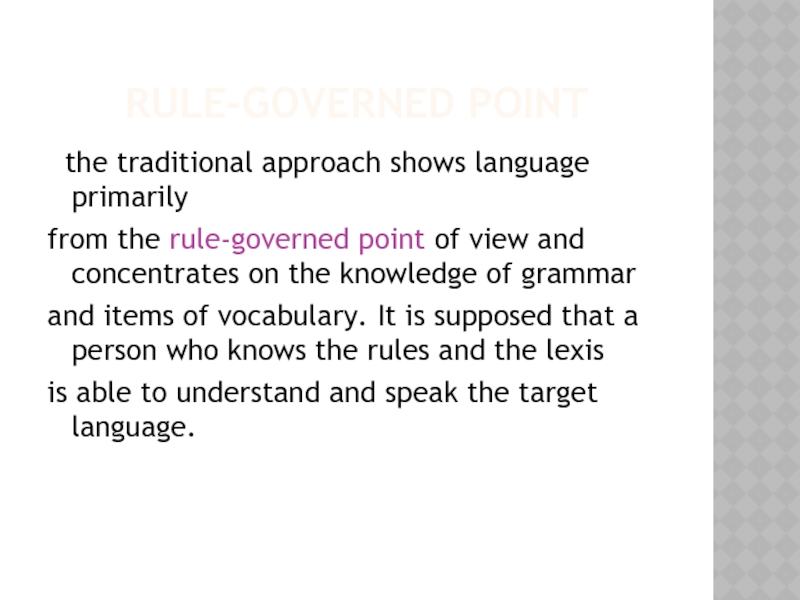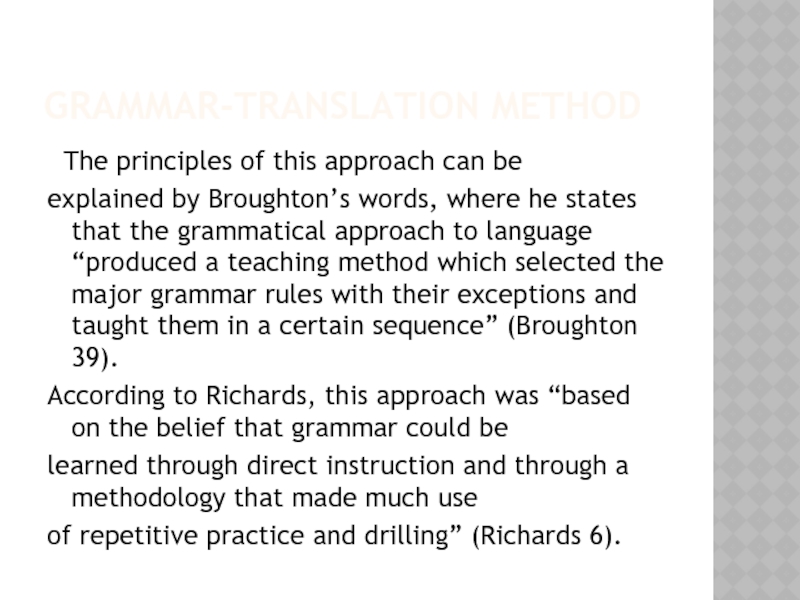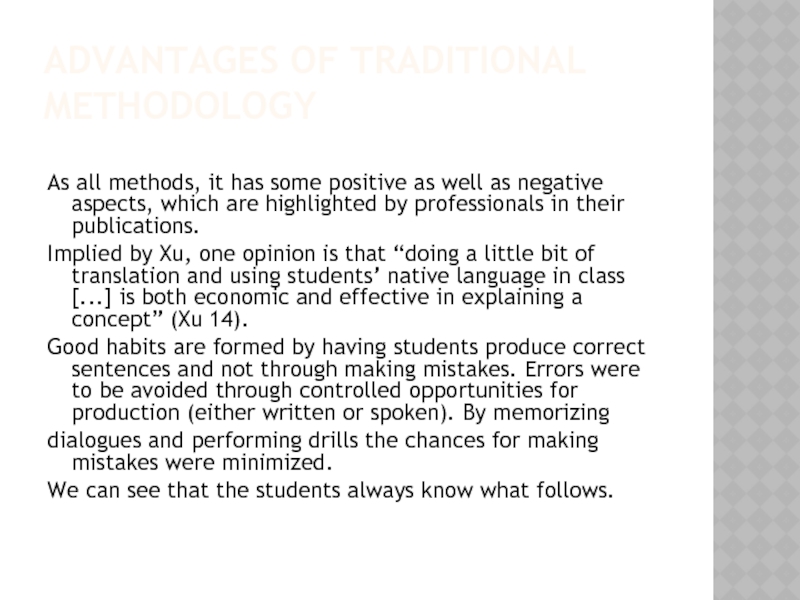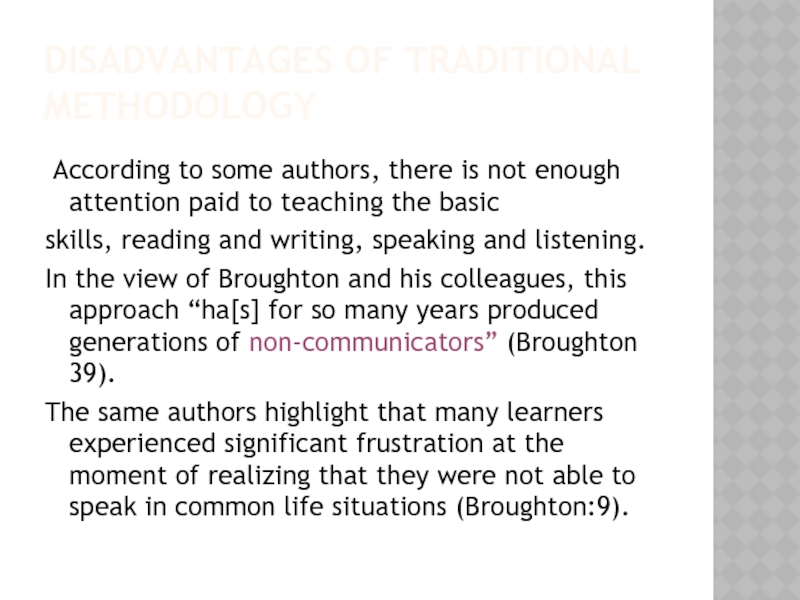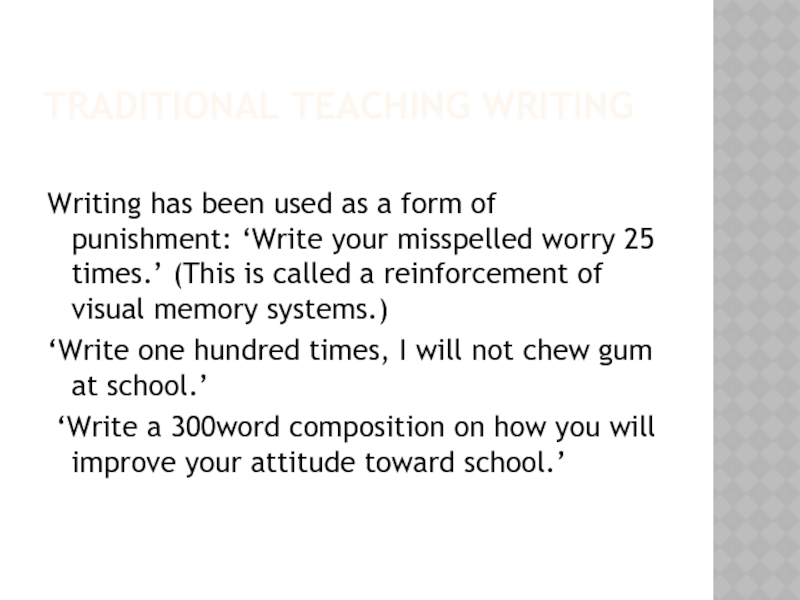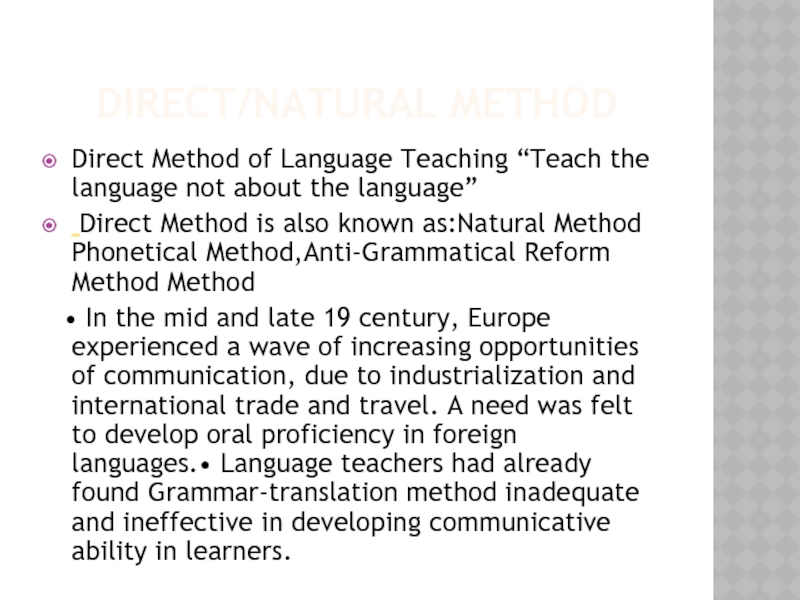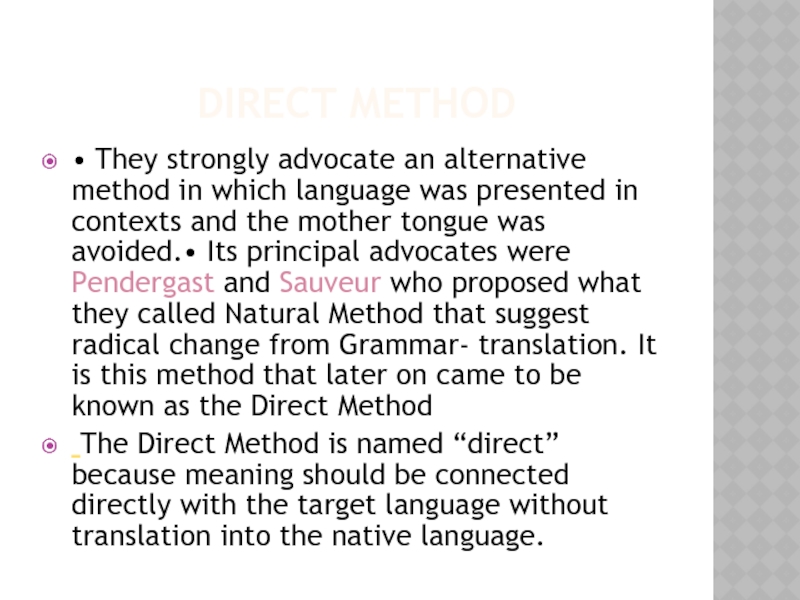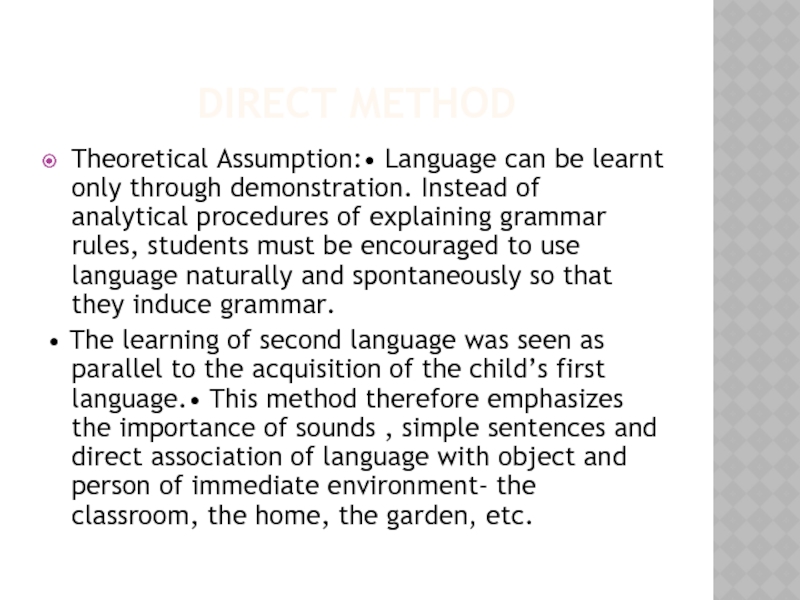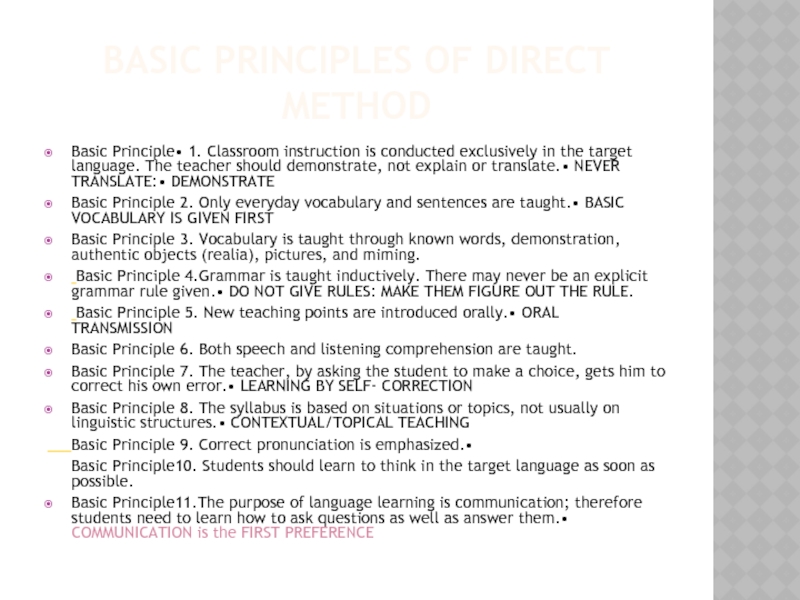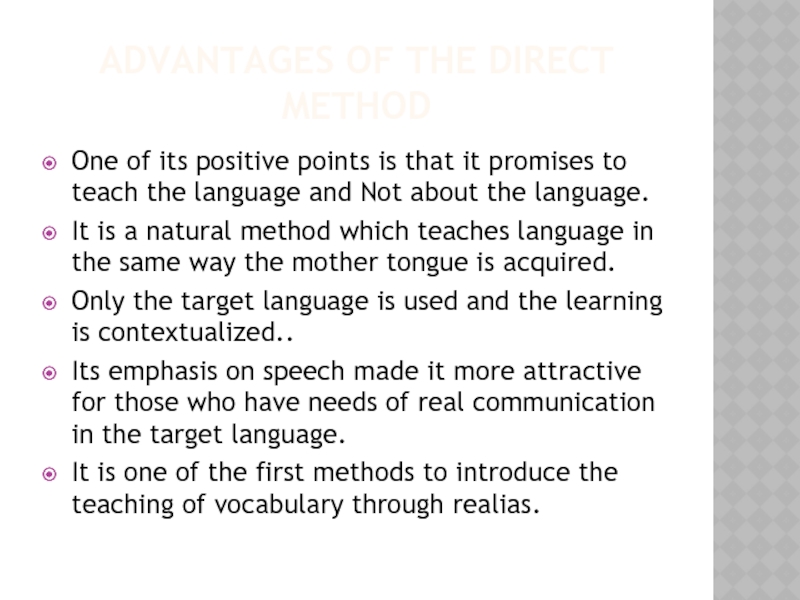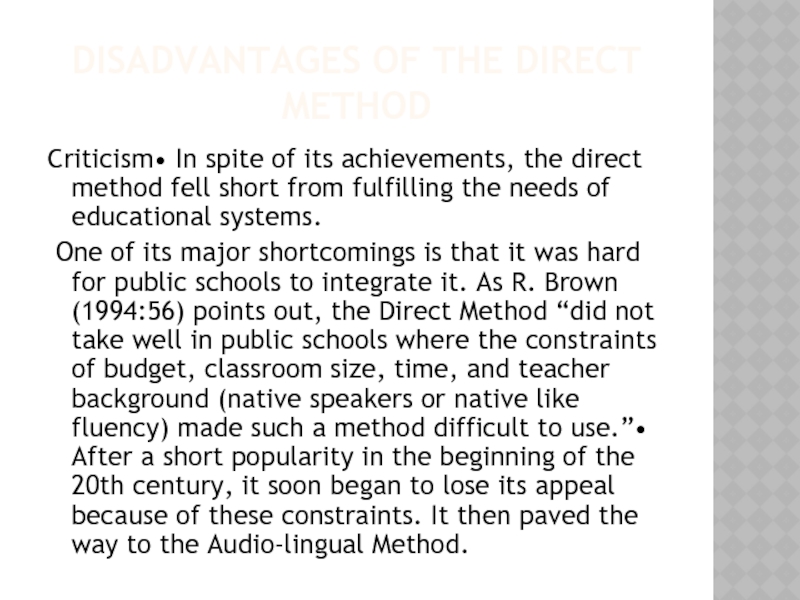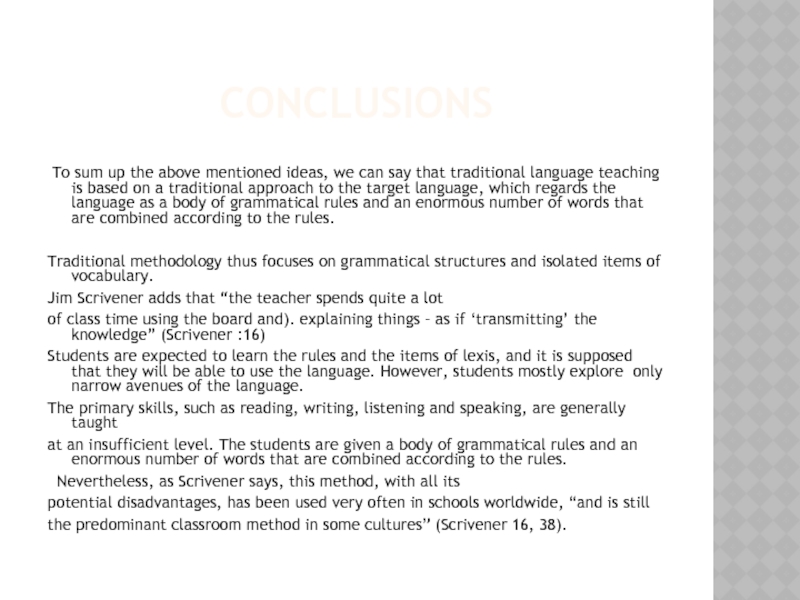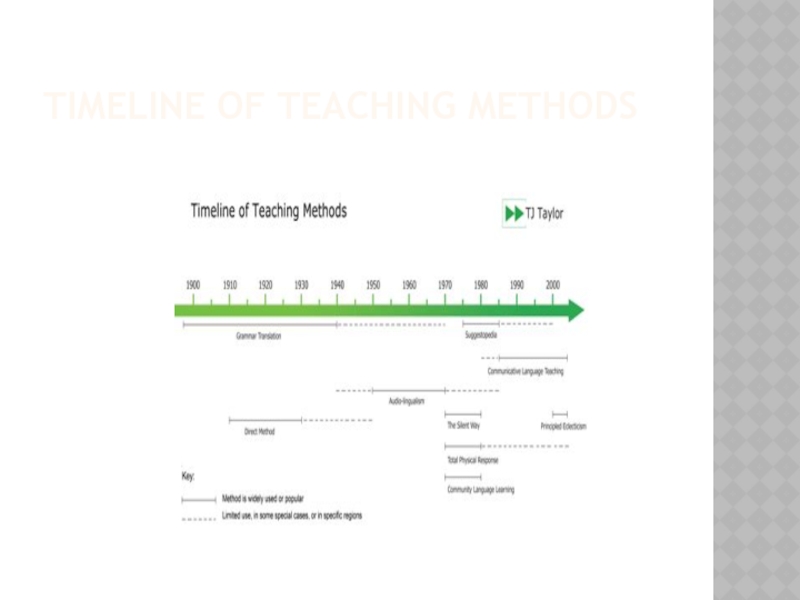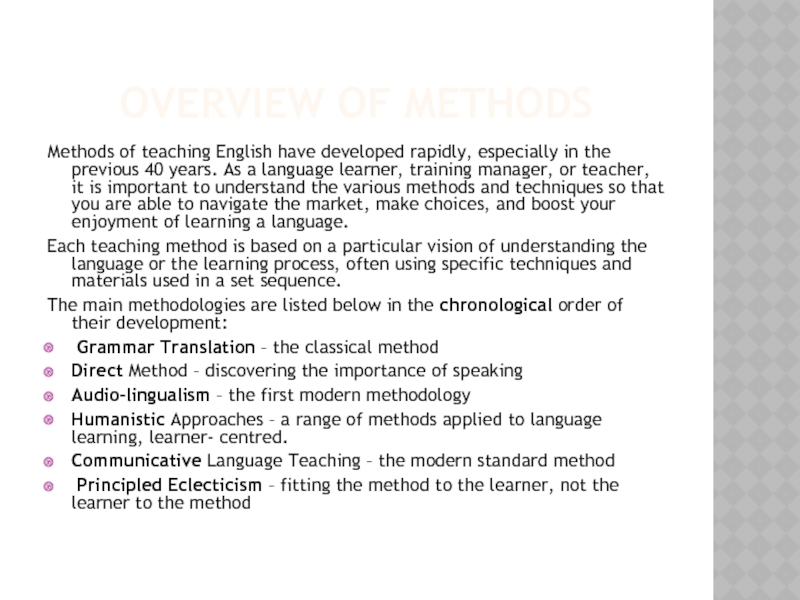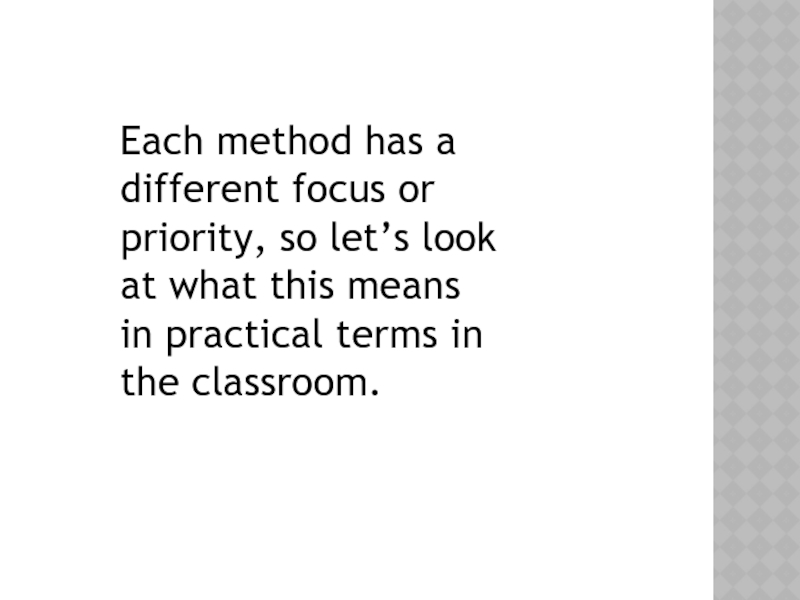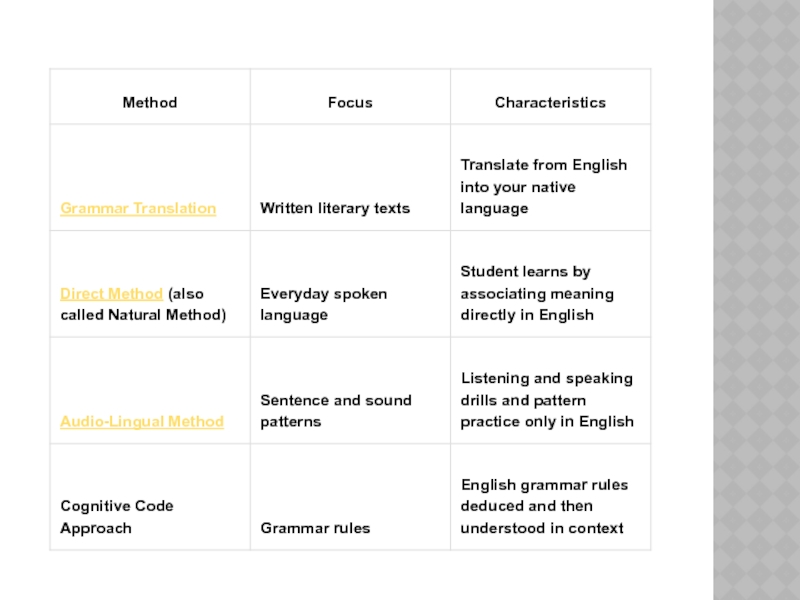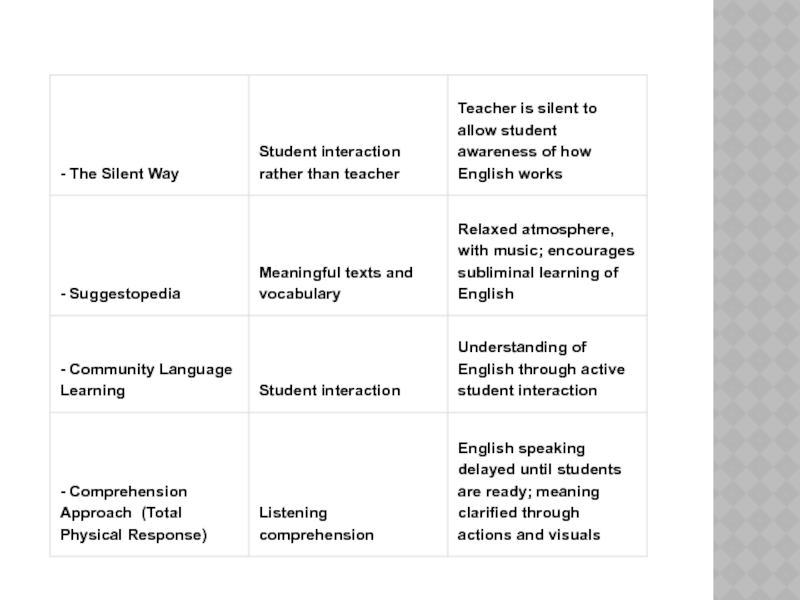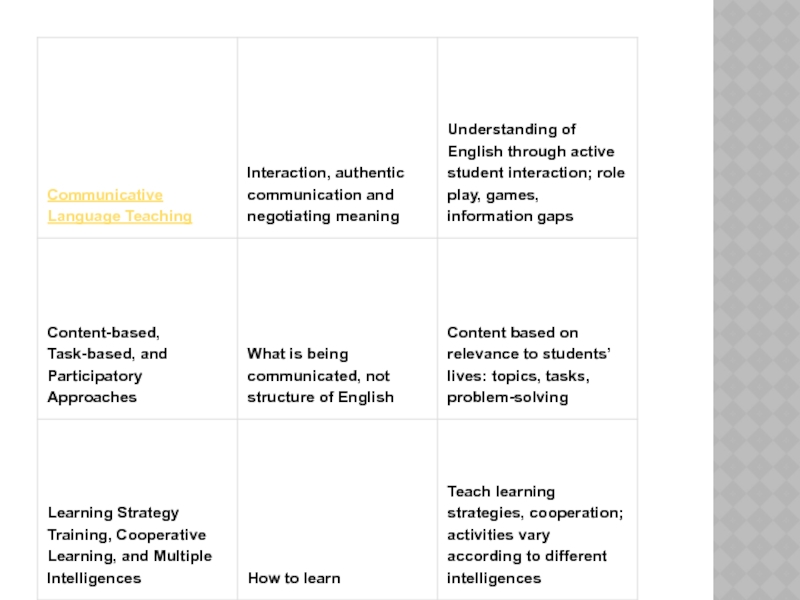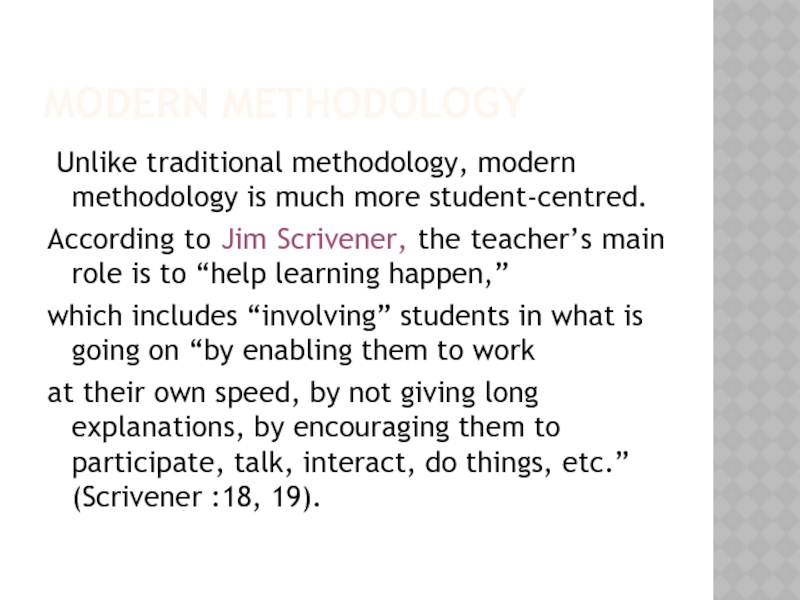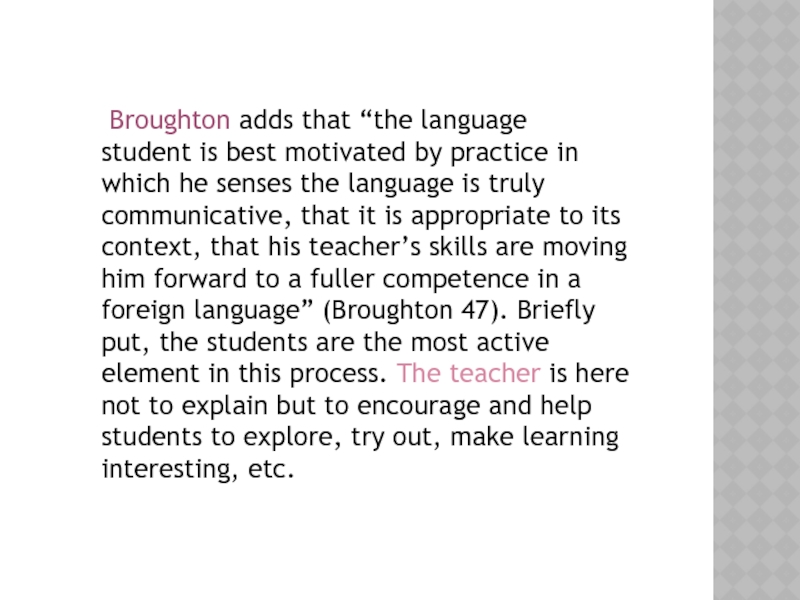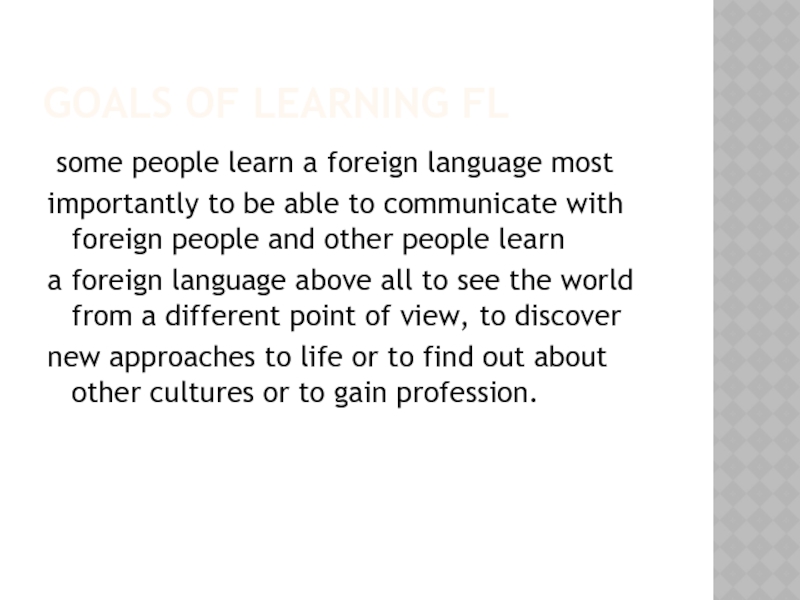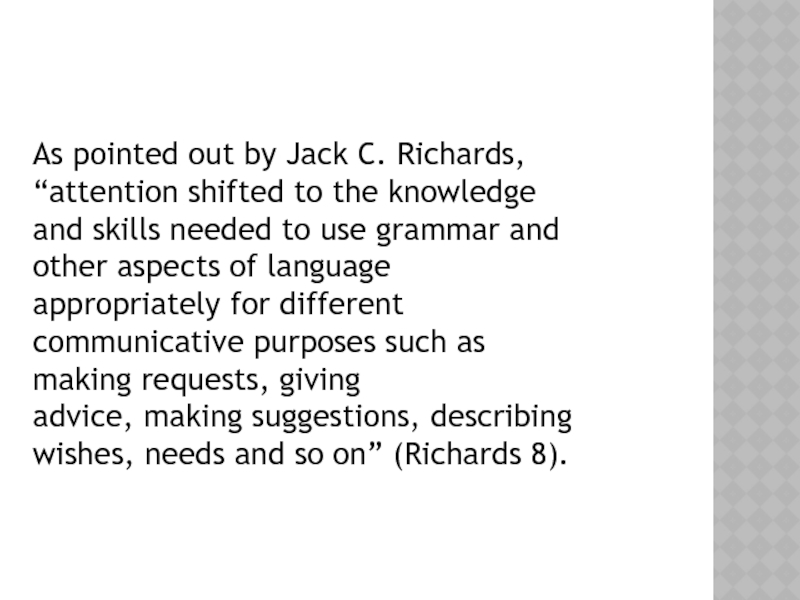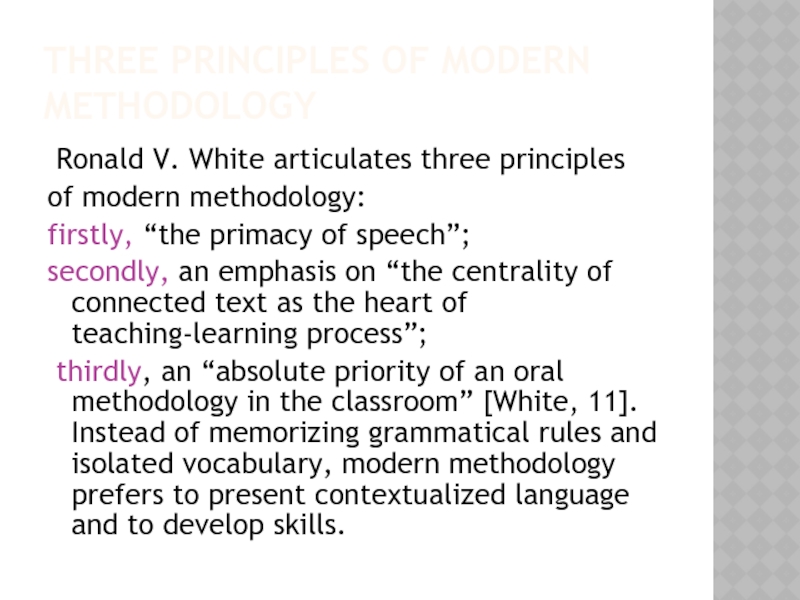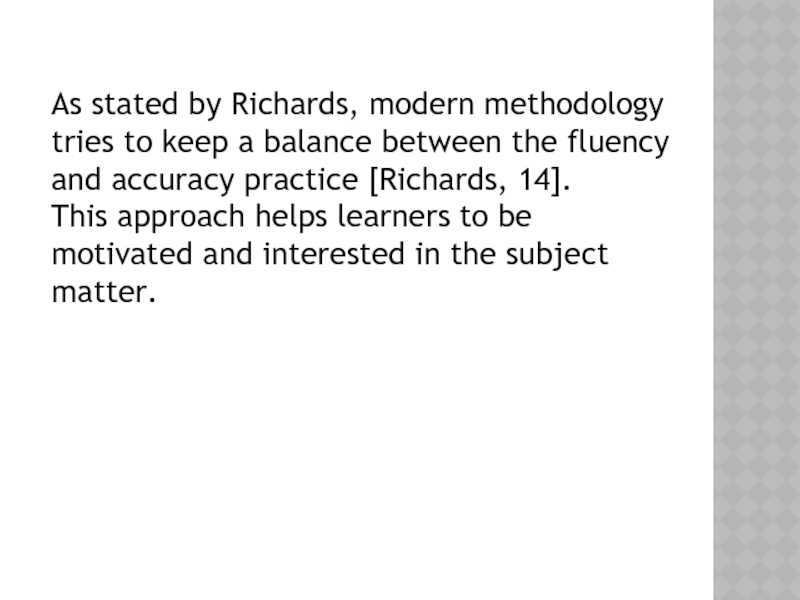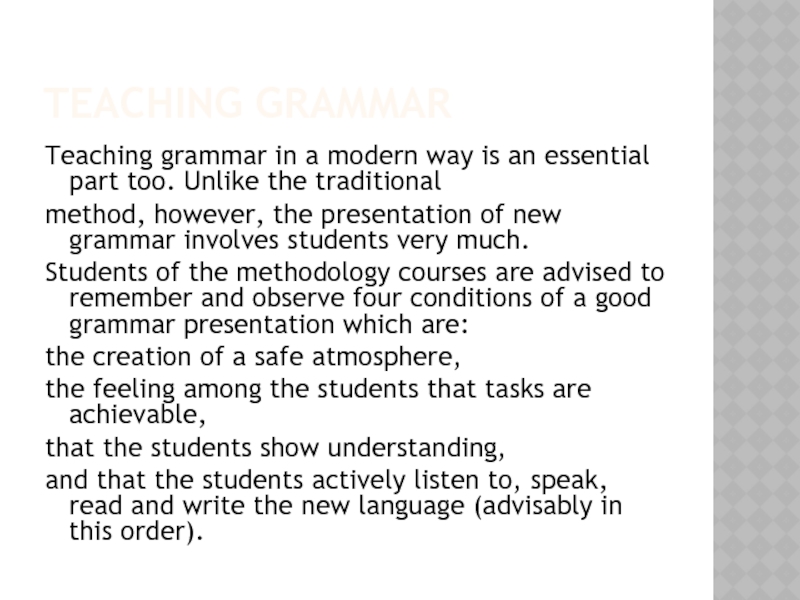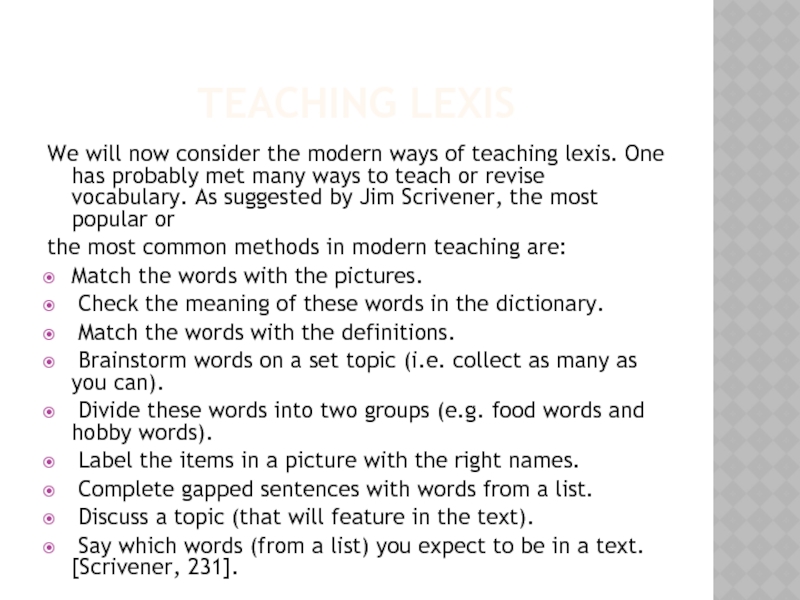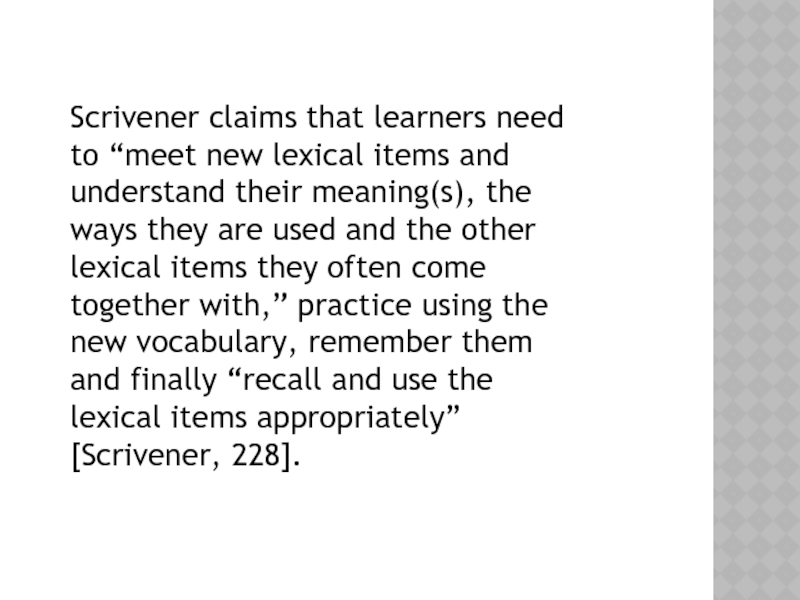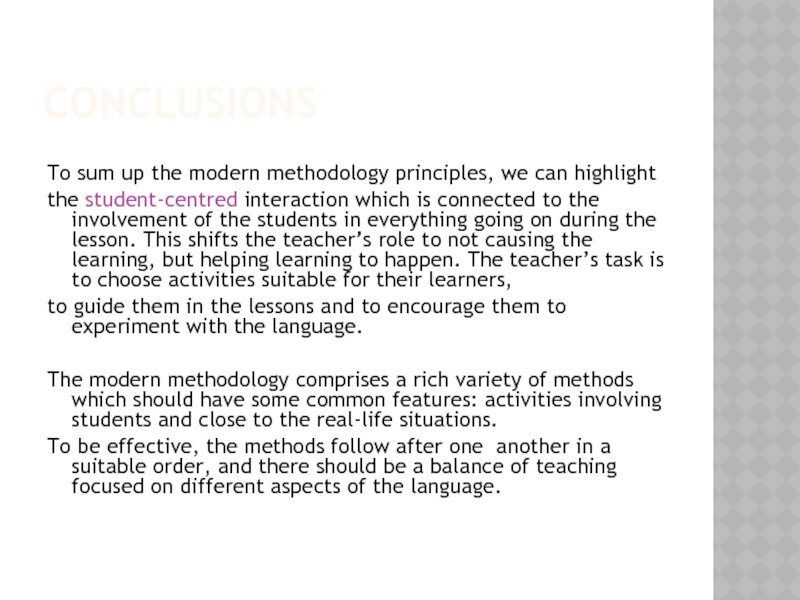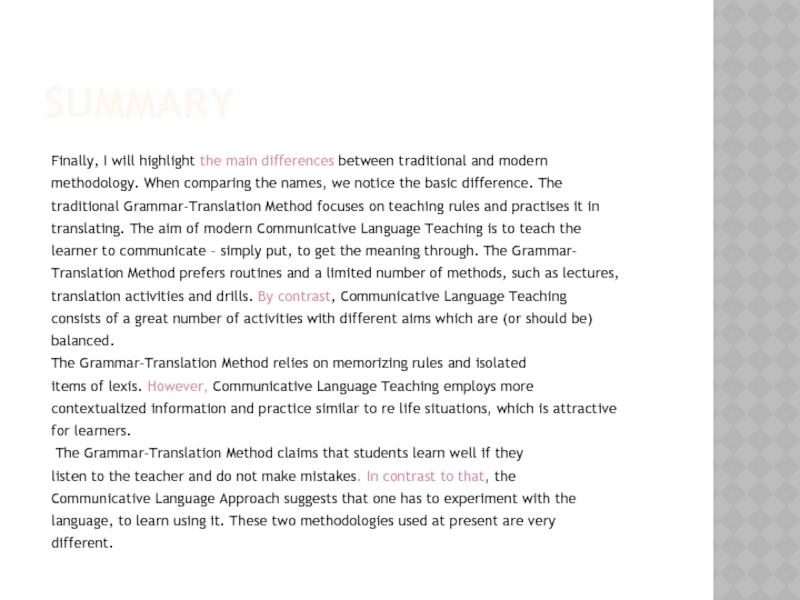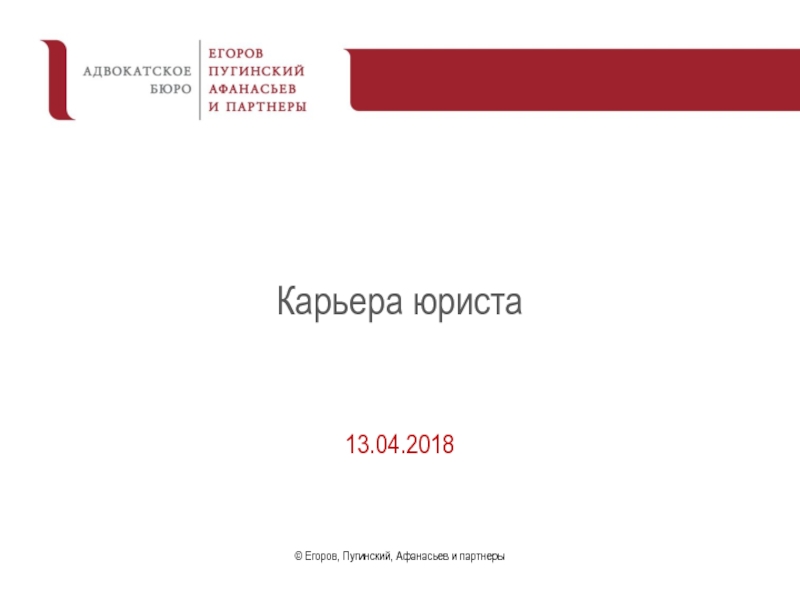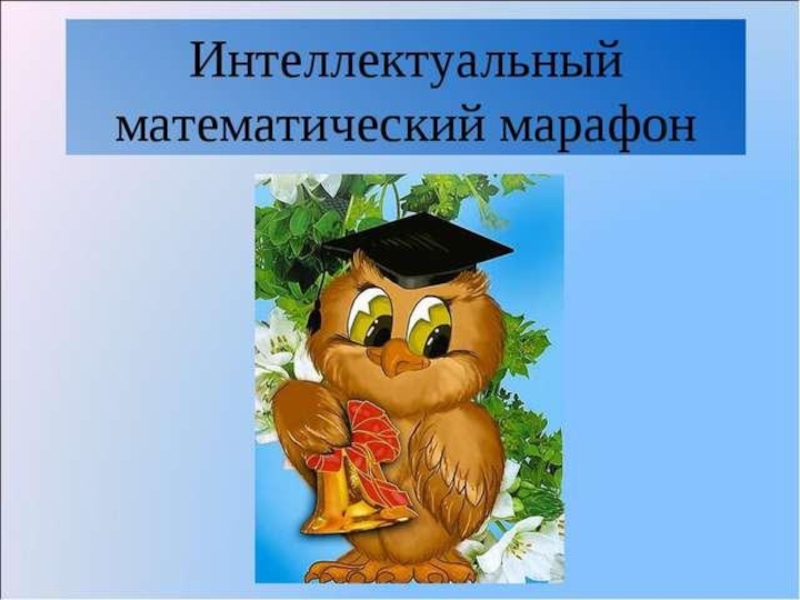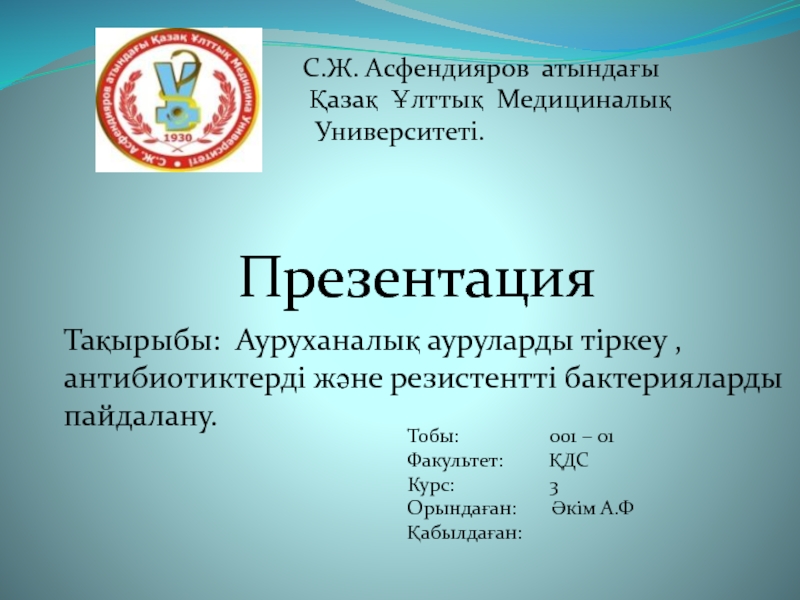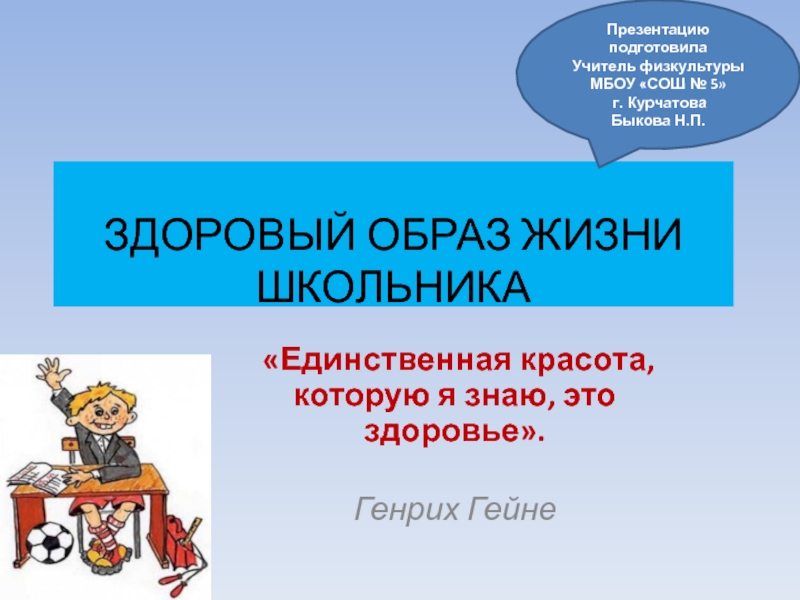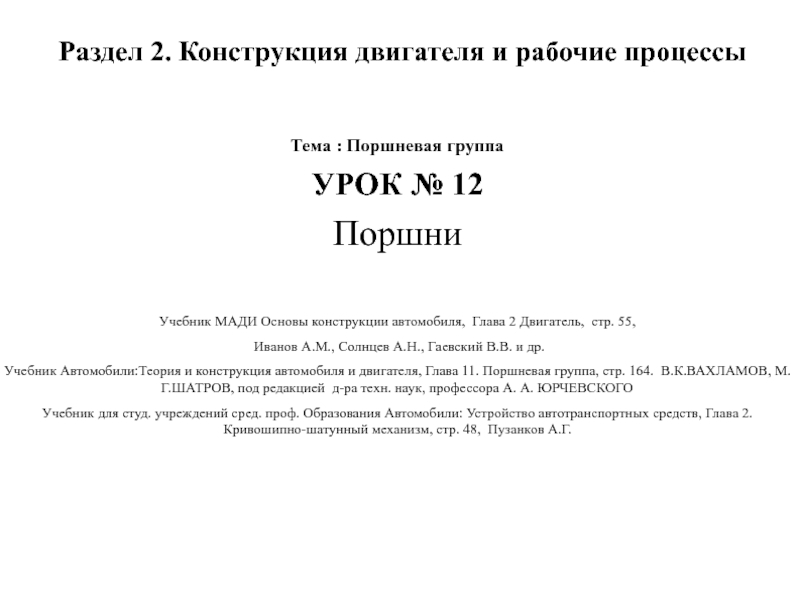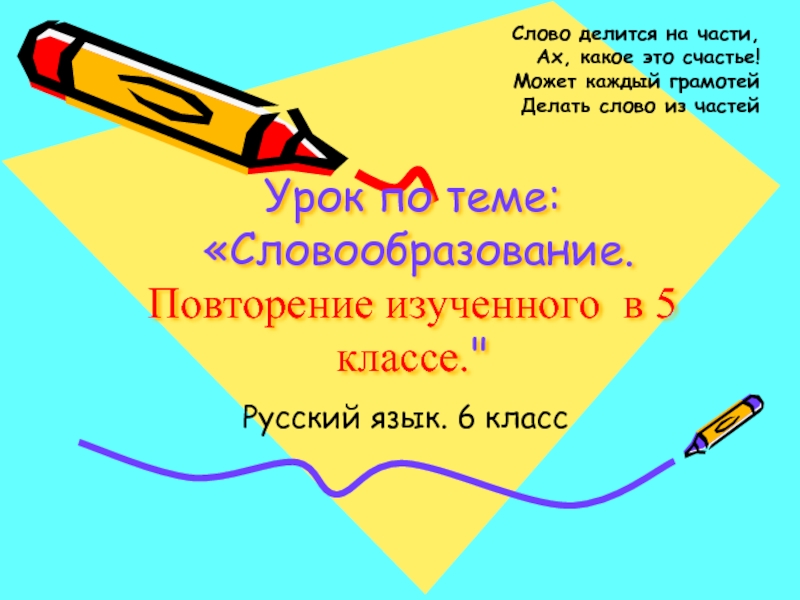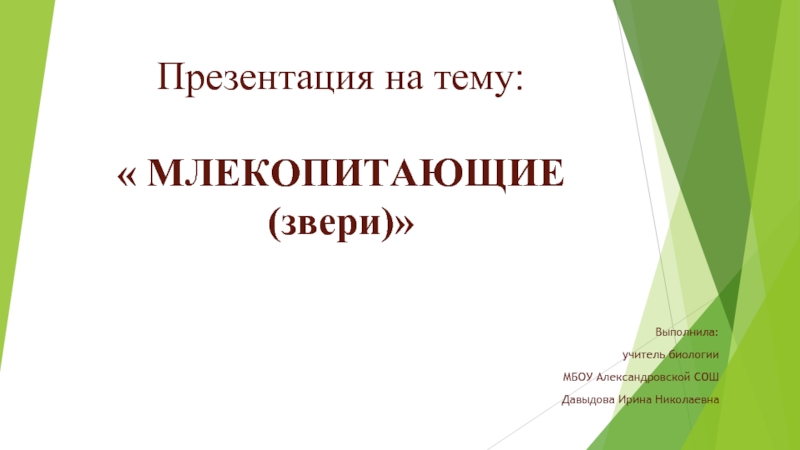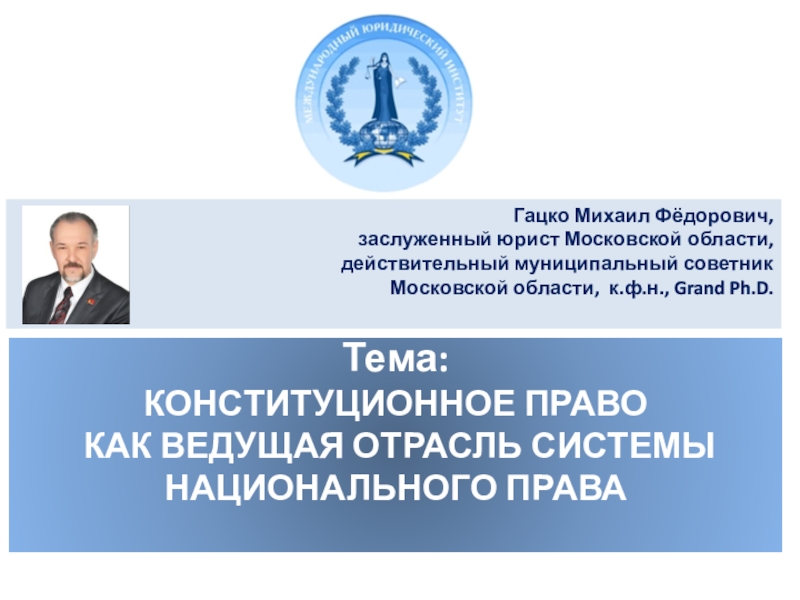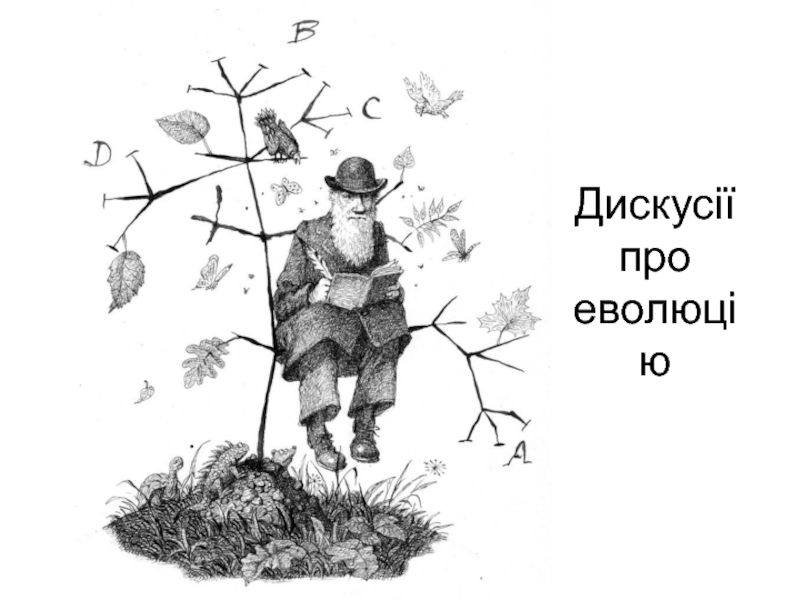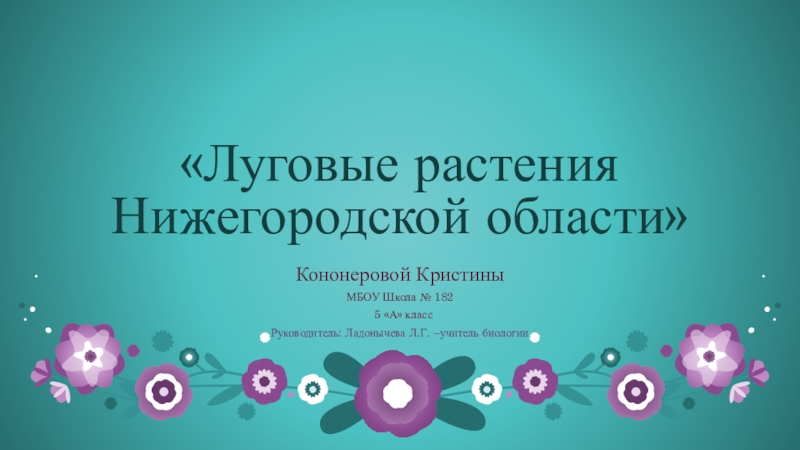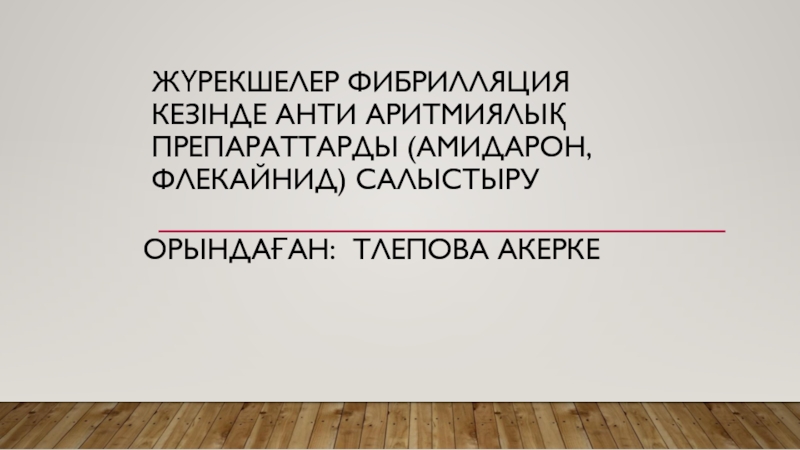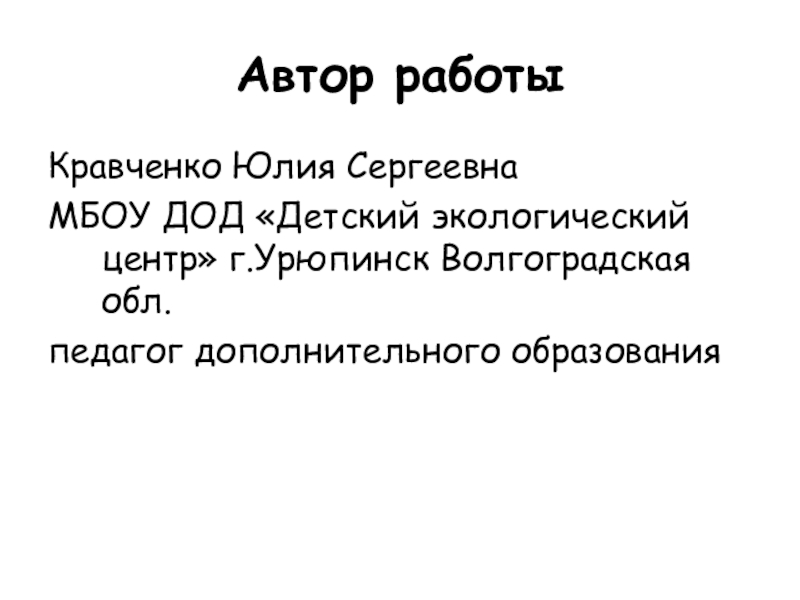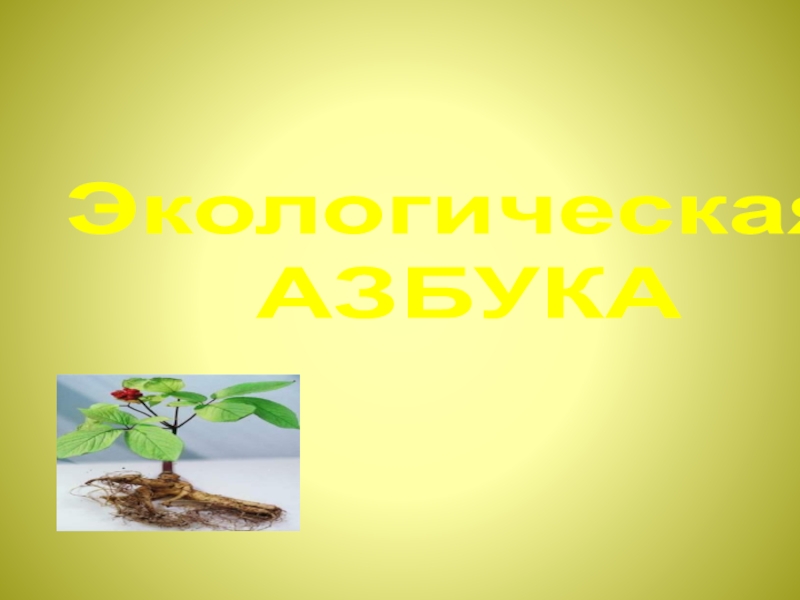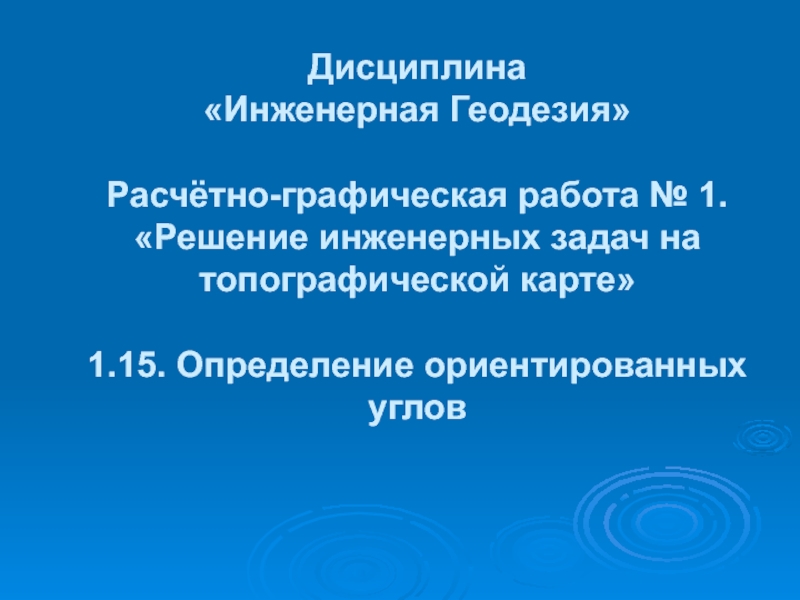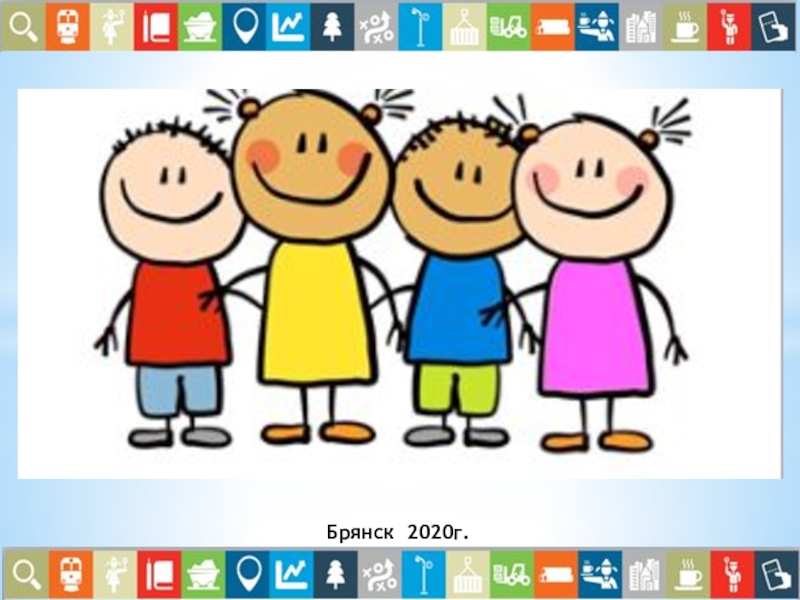Разделы презентаций
- Разное
- Английский язык
- Астрономия
- Алгебра
- Биология
- География
- Геометрия
- Детские презентации
- Информатика
- История
- Литература
- Математика
- Медицина
- Менеджмент
- Музыка
- МХК
- Немецкий язык
- ОБЖ
- Обществознание
- Окружающий мир
- Педагогика
- Русский язык
- Технология
- Физика
- Философия
- Химия
- Шаблоны, картинки для презентаций
- Экология
- Экономика
- Юриспруденция
Traditional methods of teaching English Vs. modern methods
Содержание
- 1. Traditional methods of teaching English Vs. modern methods
- 2. Method and Methodologywe can consider the method
- 3. Traditional Methodology Traditional methodologyputs the responsibility for
- 4. Rule-Governed point the traditional approach shows language
- 5. Grammar-Translation Method The principles of this approach
- 6. Advantages of Traditional MethodologyAs all methods, it
- 7. Disadvantages of Traditional Methodology According to some
- 8. Traditional Teaching WritingWriting has been used as
- 9. Direct/natural methodDirect Method of Language Teaching “Teach
- 10. DIRECT METHOD• They strongly advocate an alternative
- 11. DIRECT METHODTheoretical Assumption:• Language can be learnt
- 12. BASIC PRINCIPLES OF DIRECT METHODBasic Principle• 1.
- 13. Advantages OF THE DIRECT METHODOne of its
- 14. Disadvantages of THE Direct MethodCriticism• In spite
- 15. Conclusions To sum up the above mentioned
- 16. Timeline of Teaching Methods
- 17. OVERVIEW OF METHODSMethods of teaching English have
- 18. Each method has a different focus or
- 19. Слайд 19
- 20. Слайд 20
- 21. Слайд 21
- 22. Modern Methodology Unlike traditional methodology, modern methodology
- 23. Broughton adds that “the languagestudent is
- 24. Goals of Learning FL some people learn
- 25. As pointed out by Jack C. Richards,
- 26. Three Principles of Modern Methodology Ronald V.
- 27. As stated by Richards, modern methodology tries
- 28. Teaching GrammarTeaching grammar in a modern way
- 29. Teaching LexisWe will now consider the modern
- 30. Scrivener claims that learners need to “meet
- 31. ConclusionsTo sum up the modern methodology principles,
- 32. SummaryFinally, I will highlight the main differences
- 33. Скачать презентанцию
Method and Methodologywe can consider the method to be a well staged procedure to teach new language.we can say that methodology, or teaching in this sense, is a set of methods
Слайды и текст этой презентации
Слайд 1Traditional methods of teaching English Vs. modern methods
Presented by Associate
Professor of FL Department for Humanities
Слайд 2Method and Methodology
we can consider the method to be a
well staged procedure to teach new language.
we can say that
methodology, or teaching in this sense, is a set of methods based on the same rules and having a common aim, e.g. to encourage students to use the language: involve the students in the lesson,
or explain the language to students who have to listen attentively.
I will give details of the modern and traditional methodologies in the following part of this section.
Слайд 3Traditional Methodology
Traditional methodology
puts the responsibility for teaching and learning
mainly on the teacher and it is believed
that if students
are present at the lesson and listen to the teacher’s explanations andexamples, they will be able to use the knowledge.
This idea corresponds to the simile of Jim Scrivener, who claims that “traditional teaching [is imagined to work as] ‘jug and mug’ – the knowledge being poured from one receptacle into an empty one.”
Слайд 4Rule-Governed point
the traditional approach shows language primarily
from the rule-governed
point of view and concentrates on the knowledge of grammar
and
items of vocabulary. It is supposed that a person who knows the rules and the lexisis able to understand and speak the target language.
Слайд 5Grammar-Translation Method
The principles of this approach can be
explained
by Broughton’s words, where he states that the grammatical approach
to language “produced a teaching method which selected the major grammar rules with their exceptions and taught them in a certain sequence” (Broughton 39).According to Richards, this approach was “based on the belief that grammar could be
learned through direct instruction and through a methodology that made much use
of repetitive practice and drilling” (Richards 6).
Слайд 6Advantages of Traditional Methodology
As all methods, it has some positive
as well as negative aspects, which are highlighted by professionals
in their publications.Implied by Xu, one opinion is that “doing a little bit of translation and using students’ native language in class [...] is both economic and effective in explaining a concept” (Xu 14).
Good habits are formed by having students produce correct sentences and not through making mistakes. Errors were to be avoided through controlled opportunities for production (either written or spoken). By memorizing
dialogues and performing drills the chances for making mistakes were minimized.
We can see that the students always know what follows.
Слайд 7Disadvantages of Traditional Methodology
According to some authors, there is
not enough attention paid to teaching the basic
skills, reading and
writing, speaking and listening.In the view of Broughton and his colleagues, this approach “ha[s] for so many years produced generations of non-communicators” (Broughton 39).
The same authors highlight that many learners experienced significant frustration at the moment of realizing that they were not able to speak in common life situations (Broughton:9).
Слайд 8Traditional Teaching Writing
Writing has been used as a form of
punishment: ‘Write your misspelled worry 25 times.’ (This is called
a reinforcement of visual memory systems.)‘Write one hundred times, I will not chew gum at school.’
‘Write a 300word composition on how you will improve your attitude toward school.’
Слайд 9Direct/natural method
Direct Method of Language Teaching “Teach the language not
about the language”
Direct Method is also known as:Natural Method Phonetical
Method,Anti-Grammatical Reform Method Method• In the mid and late 19 century, Europe experienced a wave of increasing opportunities of communication, due to industrialization and international trade and travel. A need was felt to develop oral proficiency in foreign languages.• Language teachers had already found Grammar-translation method inadequate and ineffective in developing communicative ability in learners.
Слайд 10DIRECT METHOD
• They strongly advocate an alternative method in which
language was presented in contexts and the mother tongue was
avoided.• Its principal advocates were Pendergast and Sauveur who proposed what they called Natural Method that suggest radical change from Grammar- translation. It is this method that later on came to be known as the Direct MethodThe Direct Method is named “direct” because meaning should be connected directly with the target language without translation into the native language.
Слайд 11DIRECT METHOD
Theoretical Assumption:• Language can be learnt only through demonstration.
Instead of analytical procedures of explaining grammar rules, students must
be encouraged to use language naturally and spontaneously so that they induce grammar.• The learning of second language was seen as parallel to the acquisition of the child’s first language.• This method therefore emphasizes the importance of sounds , simple sentences and direct association of language with object and person of immediate environment- the classroom, the home, the garden, etc.
Слайд 12BASIC PRINCIPLES OF DIRECT METHOD
Basic Principle• 1. Classroom instruction is
conducted exclusively in the target language. The teacher should demonstrate,
not explain or translate.• NEVER TRANSLATE:• DEMONSTRATEBasic Principle 2. Only everyday vocabulary and sentences are taught.• BASIC VOCABULARY IS GIVEN FIRST
Basic Principle 3. Vocabulary is taught through known words, demonstration, authentic objects (realia), pictures, and miming.
Basic Principle 4.Grammar is taught inductively. There may never be an explicit grammar rule given.• DO NOT GIVE RULES: MAKE THEM FIGURE OUT THE RULE.
Basic Principle 5. New teaching points are introduced orally.• ORAL TRANSMISSION
Basic Principle 6. Both speech and listening comprehension are taught.
Basic Principle 7. The teacher, by asking the student to make a choice, gets him to correct his own error.• LEARNING BY SELF- CORRECTION
Basic Principle 8. The syllabus is based on situations or topics, not usually on linguistic structures.• CONTEXTUAL/TOPICAL TEACHING
Basic Principle 9. Correct pronunciation is emphasized.•
Basic Principle10. Students should learn to think in the target language as soon as possible.
Basic Principle11.The purpose of language learning is communication; therefore students need to learn how to ask questions as well as answer them.• COMMUNICATION is the FIRST PREFERENCE
Слайд 13Advantages OF THE DIRECT METHOD
One of its positive points is
that it promises to teach the language and Not about
the language.It is a natural method which teaches language in the same way the mother tongue is acquired.
Only the target language is used and the learning is contextualized..
Its emphasis on speech made it more attractive for those who have needs of real communication in the target language.
It is one of the first methods to introduce the teaching of vocabulary through realias.
Слайд 14Disadvantages of THE Direct Method
Criticism• In spite of its achievements,
the direct method fell short from fulfilling the needs of
educational systems.One of its major shortcomings is that it was hard for public schools to integrate it. As R. Brown (1994:56) points out, the Direct Method “did not take well in public schools where the constraints of budget, classroom size, time, and teacher background (native speakers or native like fluency) made such a method difficult to use.”• After a short popularity in the beginning of the 20th century, it soon began to lose its appeal because of these constraints. It then paved the way to the Audio-lingual Method.
Слайд 15Conclusions
To sum up the above mentioned ideas, we
can say that traditional language teaching is based on a
traditional approach to the target language, which regards the language as a body of grammatical rules and an enormous number of words that are combined according to the rules.Traditional methodology thus focuses on grammatical structures and isolated items of vocabulary.
Jim Scrivener adds that “the teacher spends quite a lot
of class time using the board and). explaining things – as if ‘transmitting’ the knowledge” (Scrivener :16)
Students are expected to learn the rules and the items of lexis, and it is supposed that they will be able to use the language. However, students mostly explore only narrow avenues of the language.
The primary skills, such as reading, writing, listening and speaking, are generally taught
at an insufficient level. The students are given a body of grammatical rules and an enormous number of words that are combined according to the rules.
Nevertheless, as Scrivener says, this method, with all its
potential disadvantages, has been used very often in schools worldwide, “and is still
the predominant classroom method in some cultures” (Scrivener 16, 38).
Слайд 17OVERVIEW OF METHODS
Methods of teaching English have developed rapidly, especially
in the previous 40 years. As a language learner, training
manager, or teacher, it is important to understand the various methods and techniques so that you are able to navigate the market, make choices, and boost your enjoyment of learning a language.Each teaching method is based on a particular vision of understanding the language or the learning process, often using specific techniques and materials used in a set sequence.
The main methodologies are listed below in the chronological order of their development:
Grammar Translation – the classical method
Direct Method – discovering the importance of speaking
Audio-lingualism – the first modern methodology
Humanistic Approaches – a range of methods applied to language learning, learner- centred.
Communicative Language Teaching – the modern standard method
Principled Eclecticism – fitting the method to the learner, not the learner to the method
Слайд 18Each method has a different focus or priority, so let’s
look at what this means in practical terms in the
classroom.Слайд 22Modern Methodology
Unlike traditional methodology, modern methodology is much more
student-centred.
According to Jim Scrivener, the teacher’s main role is to
“help learning happen,”which includes “involving” students in what is going on “by enabling them to work
at their own speed, by not giving long explanations, by encouraging them to participate, talk, interact, do things, etc.” (Scrivener :18, 19).
Слайд 23
Broughton adds that “the language
student is best motivated by
practice in which he senses the language is truly
communicative, that
it is appropriate to its context, that his teacher’s skills are movinghim forward to a fuller competence in a foreign language” (Broughton 47). Briefly put, the students are the most active element in this process. The teacher is here not to explain but to encourage and help students to explore, try out, make learning interesting, etc.
Слайд 24Goals of Learning FL
some people learn a foreign language
most
importantly to be able to communicate with foreign people and
other people learna foreign language above all to see the world from a different point of view, to discover
new approaches to life or to find out about other cultures or to gain profession.
Слайд 25As pointed out by Jack C. Richards, “attention shifted to
the knowledge and skills needed to use grammar and other
aspects of languageappropriately for different communicative purposes such as making requests, giving
advice, making suggestions, describing wishes, needs and so on” (Richards 8).
Слайд 26Three Principles of Modern Methodology
Ronald V. White articulates three
principles
of modern methodology:
firstly, “the primacy of speech”;
secondly, an
emphasis on “the centrality of connected text as the heart of teaching-learning process”; thirdly, an “absolute priority of an oral methodology in the classroom” [White, 11]. Instead of memorizing grammatical rules and isolated vocabulary, modern methodology prefers to present contextualized language and to develop skills.
Слайд 27As stated by Richards, modern methodology tries to keep a
balance between the fluency
and accuracy practice [Richards, 14].
This approach helps
learners to be motivated and interested in the subject matter.Слайд 28Teaching Grammar
Teaching grammar in a modern way is an essential
part too. Unlike the traditional
method, however, the presentation of new
grammar involves students very much.Students of the methodology courses are advised to remember and observe four conditions of a good grammar presentation which are:
the creation of a safe atmosphere,
the feeling among the students that tasks are achievable,
that the students show understanding,
and that the students actively listen to, speak, read and write the new language (advisably in this order).
Слайд 29Teaching Lexis
We will now consider the modern ways of teaching
lexis. One has probably met many ways to teach or
revise vocabulary. As suggested by Jim Scrivener, the most popular orthe most common methods in modern teaching are:
Match the words with the pictures.
Check the meaning of these words in the dictionary.
Match the words with the definitions.
Brainstorm words on a set topic (i.e. collect as many as you can).
Divide these words into two groups (e.g. food words and hobby words).
Label the items in a picture with the right names.
Complete gapped sentences with words from a list.
Discuss a topic (that will feature in the text).
Say which words (from a list) you expect to be in a text. [Scrivener, 231].
Слайд 30Scrivener claims that learners need to “meet new lexical items
and understand their meaning(s), the ways they are used and
the other lexical items they often cometogether with,” practice using the new vocabulary, remember them and finally “recall and use the lexical items appropriately” [Scrivener, 228].
Слайд 31Conclusions
To sum up the modern methodology principles, we can highlight
the student-centred interaction which is connected to the involvement of
the students in everything going on during the lesson. This shifts the teacher’s role to not causing the learning, but helping learning to happen. The teacher’s task is to choose activities suitable for their learners,to guide them in the lessons and to encourage them to experiment with the language.
The modern methodology comprises a rich variety of methods which should have some common features: activities involving students and close to the real-life situations.
To be effective, the methods follow after one another in a suitable order, and there should be a balance of teaching focused on different aspects of the language.
Слайд 32Summary
Finally, I will highlight the main differences between traditional and
modern
methodology. When comparing the names, we notice the basic difference.
Thetraditional Grammar-Translation Method focuses on teaching rules and practises it in
translating. The aim of modern Communicative Language Teaching is to teach the
learner to communicate – simply put, to get the meaning through. The Grammar-
Translation Method prefers routines and a limited number of methods, such as lectures,
translation activities and drills. By contrast, Communicative Language Teaching
consists of a great number of activities with different aims which are (or should be)
balanced.
The Grammar-Translation Method relies on memorizing rules and isolated
items of lexis. However, Communicative Language Teaching employs more
contextualized information and practice similar to re life situations, which is attractive
for learners.
The Grammar-Translation Method claims that students learn well if they
listen to the teacher and do not make mistakes. In contrast to that, the
Communicative Language Approach suggests that one has to experiment with the
language, to learn using it. These two methodologies used at present are very
different.
